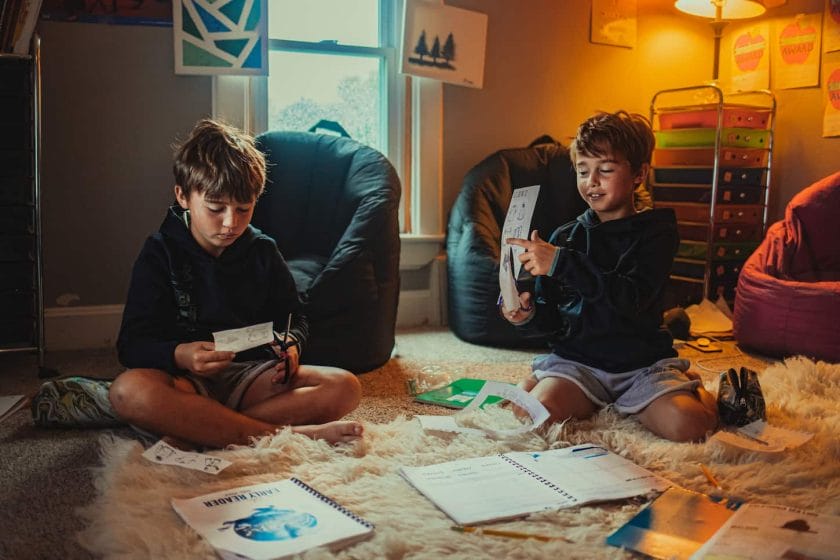A lot of advice for homeschoolers seems targeted at those who want to make homeschooling a long-term lifestyle. However, there are situations where families wish to homeschool temporarily, whether for a month or a few years.
Homeschooling does not have to be permanent. There are many reasons why families opt to homeschool on a short-term basis, whether it is for one month or a couple of years. Just as it is possible to switch from public to homeschooling, the opposite is also doable at any time.
So, why and how does temporary homeschooling happen? Is it possible to homeschool for a while without fully committing to the switch? Let’s take a look at the details.

Can I Temporarily Homeschool My Child for Any Reason?
Parents can decide to homeschool their children at any time, for any reason. This is true whether the choice is to homeschool long or short-term. Ultimately, it comes down to what is best for the child, whether homeschooling or conventional school.
Of course, the coronavirus pandemic was a recent situation that led many families to unexpectedly switch to learning at home. However, COVID-19 is far from the only motivation to homeschool in the short term.
Here are a few of the other common reasons to homeschool temporarily.
- Still looking for a good school following a move.
- The child is having social difficulties at school.
- The child needs more one-on-one academic help.
- Family situations, such as caring for a sick relative.
- Concern for the child’s physical and mental health.
- Seeking to strengthen family bonds.
- Schools affected by an emergency or tragedy.
- Issues with the child’s teacher in their current grade.
Temporary homeschooling can also be used to try it out for those unsure if it would be a good long-term solution for their family. Some families who homeschool temporarily for other reasons find it to be such a good fit that they decide to turn temporary into permanent.
The reasons and timeframe for choosing to homeschool will be somewhat different for every child’s situation. Parents do not owe anyone an explanation for making the best choice for their child, which may include making homeschooling a step in their journey, whether for a short or long time.
How Fast Can You Switch to Homeschooling?
Parents can make the change at any time during the year. The exact process of withdrawing a child from school to homeschool varies based on location, state law, and district rules. It is usually easiest to switch to homeschooling at the beginning of the school year.
Please check out our article on taking your child out of public school for some initial steps to take when starting out. While you can do it most any time, the summer break allows enough time to figure out state and district policies and go through all the official procedures involved with the transition.
However, changing after the school year has already started is sometimes necessary. This may be more difficult, but sometimes it is the best choice for a child’s well-being. It is certainly possible to switch to homeschooling anytime, regardless of the traditional school year schedule.
At whatever point there is a need to switch to homeschooling, the most important steps are researching state policy and contacting the local school district to find out about requirements. Homeschooling is legal in all 50 states, but the details look different depending on the location.

How Do I Homeschool My Child for the Short Term?
Homeschooling is not known to be a one-size-fits-all approach to education. There are unique methods, ranging from classical to unschooling and including everything in between. The options are just as open for temporary homeschooling.
That said, short-term homeschooling may look somewhat different than more permanent situations. Long-term homeschoolers can try out many different curricula and schooling styles until they find the one that fits them best.
However, this may not be the best approach for temporary homeschooling, especially if it’s for one year or less. Switching between programs over such a short duration can create a scattered feel and make it more difficult for students to learn.
After all, it takes time to learn new systems and programs. Everyone (parent and child) will need time to adjust to each new change.
When homeschooling temporarily, the best option may be to research and choose a curriculum that seems like a good fit and then stick with it. No homeschool program is perfect, but at least the students will be learning.
Of course, short-term homeschooling is known to sometimes turn into long-term homeschooling unexpectedly. If this happens, there is the opportunity to experiment with more curricula and approaches to homeschooling. As with most aspects of homeschooling, flexibility is key.
Can you use public school materials for homeschooling?
Sometimes, families homeschooling temporarily may find it easiest to use the same curriculum as their local school rather than materials specifically intended for homeschooling. This also ensures an easy transition back to school for the student.
Both traditional and homeschool curricula have their merits for temporary homeschooling. If using the resources from the child’s former or future school seems the best option, it is certainly possible to contact the school and ask for materials.
Just note that they will not be designed for use in a home education context, which may complicate things.
In that case, some curriculums are similar to the school-based programs that can be used, like Saxon math (I’ll admit it’s our math program, and we love it).
Where do I get help for temporary homeschooling?
There are countless websites, support groups, co-ops, local groups, church groups, and other resources with advice and support for homeschooled families. These are just as helpful and readily available regardless of the timeframe being used for homeschooling.
Co-ops can be an appealing option for temporary homeschooling. They free the parent from the stress of doing everything independently and allow for socialization and a smoother transition out of the school environment for the newly homeschooled kids.
Co-ops also provide the chance to meet and learn from more experienced homeschooling parents.
Some co-ops are more involved than others, so be patient and thorough in your search.
- My friend and her children participate in a co-op where she helps teach some of the classes.
- This last school year, my children participated in a theater co-op where I dropped them off (because I don’t know enough about it to be helpful, though I did volunteer as a stage mom at the performances), and they got to have fun with their teachers and co-op friends.
My point is there are a lot of co-op options. So don’t be afraid to do some searching. And hopefully, a local theater company near you may offer a for-profit theater co-op (that supports the theater and arts) if that’s what you want, too.
In looking at co-ops, though, know that some of them will have rules about commitments. So if they require year-long or semester-long enrollment, that may be problematic for some types of temporary homeschooling plans.

How Do I Keep My Temporarily Homeschooled Kids Busy?
Temporary homeschooling, especially when done for less than a year, allows much more leeway in terms of content than long-term homeschooling. Without the need to meet state educational requirements or think about college prep, the main concern is to keep kids learning and engaged.
Parents who used to send their children to school may be worried that withdrawing them will lead to sitting around the house all day with nothing to do. However, there are so many ways to make learning at home happen in a fun, rewarding, and productive way.
What are options besides traditional curricula?
Online courses, books and programs from the local public library, nature observation, and involvement with sports or clubs can all be ways to continue children’s education while they are temporarily out of school.
They can also undertake creative projects such as drawing, writing, making music, gardening, or cooking.
Most homeschool curricula are designed with the intent of completion over a traditional school year. Parents may not want to bother investing in these programs when they know they will not finish them.
Students can learn just as well from a more eclectic approach as from structured educational programs.
Sometimes parents choose to pursue temporary homeschooling because a child is struggling or falling behind in one particular subject.
Teaching at home provides a great opportunity to focus education on a student’s most significant needs or interests instead of following the cookie-cutter approach of the mainstream school system.
Where can I find educational resources to use for short-term homeschooling?
There are countless educational resources online and in-person for short-term homeschooling. Usually, online options are easier to find and tend to be more flexible for short-term homeschooling.
Below are some helpful websites that offer useful materials for temporary homeschooling. But first, a couple of notes about our list.
Free resources are marked with an asterisk (*).
Some premium resources offer 30-day free trials, which could be the perfect fit for a temporary homeschool situation.
All of these links open in new windows, and we have no affiliation with them.
- ABC Mouse
- All About Learning*
- All-In-One Homeschool*
- Education.com*
- K5 Learning
- Khan Academy*
- Literary Adventures for Kids*
- Outschool
- Read Aloud Revival*
- Reading Eggs
- Teachstarter
- Twinkl*
For reference, we’ve used several of these resources.
- We’ve used Reading Eggs (along with its Math Seeds partner program) for several years while our kids were first learning to read. They loved it.
- We’ve used Khan Academy, especially its math program. It ended up being a solid temporary option that was a great stopgap until we found that our kids do well with Saxon math.
- We haven’t personally tried all these options, as my kids prefer in-person and book learning over online or virtual learning. However, they’re more than happy for online if it’s the only option (like the Mark Rober engineering class).
- We have done one-off classes on Outschool. Some were great, and others are not a repeat, but the platform is incredible and offers a great selection of paid courses.
There are also countless other educational resources available on the internet. As mentioned above, local or internet-based homeschool groups can also be helpful places to find learning opportunities for temporarily homeschooled students.

Key Takeaways and Next Steps
Temporary homeschooling is an option a family can pursue whenever a child needs time away from traditional school, regardless of the specific cause for this. It might seem daunting to switch to teaching at home, but there are ways to make it easier.
If temporary homeschooling seems appealing but overwhelming, there are many ways to reduce the stress and uncertainty involved.
Libraries, homeschool groups, and online education programs can all support the temporarily homeschooling parent. Many of these options are free or available at a very low cost.
Families interested in temporary homeschooling should start by finding out how to withdraw their child from school. Once that process is completed, they can begin the exciting journey of learning at home. Who knows? Perhaps it might not be such a temporary arrangement after all.
We hope you have learned a lot from us today. If you want further reading on homeschooling, check these out below.
- Cost of Homeschooling vs. Public School Compared (2022 Update)
- Guide to Homeschooling Large Family Style
- How Do I Take My Child out of School to Homeschool?
They’re all great resources designed to support you in your homeschooling journey (whether you’re in the research or implementation phases). And if we don’t have the resource you need yet? Contact us with your question so we can fix that ASAP.
Resources
Learning from your own experience is important, but learning from others is also smart. These are the sources used in this article and our research to be more informed as homeschoolers.
- Faulconer, J. (2022). Short-term and temporary homeschooling. The Homeschool Mom. https://www.thehomeschoolmom.com/short-term-homeschooling/.
- Holly. (2022). Temporary homeschooling schedule. Simplify Create Inspire. https://www.simplifycreateinspire.com/temporary-home-schooling-schedule/
- Jennifer. Best temporary homeschooling resources. The Organized Homeschooler. https://www.organizedhomeschooler.com/temporary-homeschooling-resources/.
- Jorawsky, K. (2022). Guide to temporary homeschooling. Study.com. https://study.com/academy/popular/guide-to-temporary-homeschooling.html.
- Macias, R. Can I do temporary homeschooling while moving? Dad Cares Too. https://www.dadcarestoo.com/can-i-do-temporary-homeschooling-while-moving/.
- Tingom, J. (2020). Temporary homeschooling and how to make it work. Phoenix with Kids. https://www.phoenixwithkids.net/temporary-homeschooling-how-to-make-it-work/.
